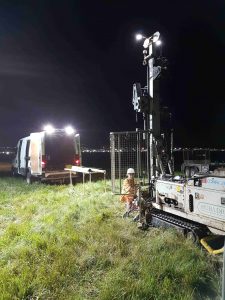With warmer weather arriving, we received a timely request from Micasa to assist them with the design and construction of a swimming pool for a residential client. All in a day’s work for our Terrier drill rig, which is particularly suited to this work, having a small footprint and being able to pass through a standard doorway. The only problem: our site team were left imagining taking a refreshing dip in the pool, which won’t be completed for a few months yet.
Practical (Geotechnical) Magic
We were called to the rescue of a local home owner recently. They had been told, by both Building Control and their builder, that they needed to make substantial improvements to their existing foundations in order to be able to add a first floor extension to their property. The existing foundations had been signed off by Building Control, a number of years previously, but were considered insufficiently deep and wide to support the additional loads of the proposed extension.
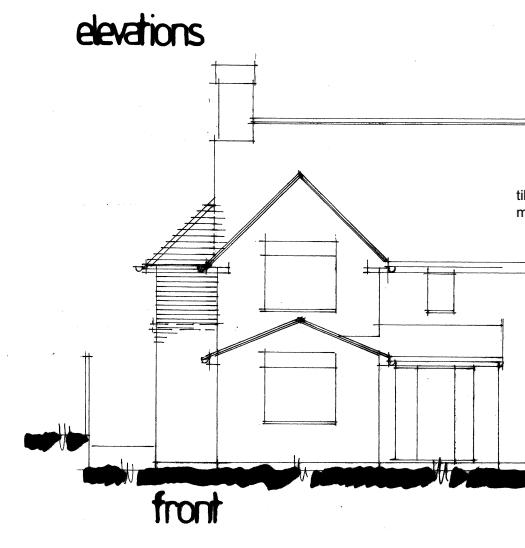
To add to the problem, the existing foundations were off-set from the line of the existing walls, but there was no indication to suggest they would be inadequate. When we asked what information Building Control had used to reach their conclusion all we got in response was ‘it’s just not what we usually see’. We thought we could (and should) do a little better than that…
Given our knowledge of the local geology, we knew the property was likely to sit directly onto the bedrock chalk, which being ‘rock’ is usually pretty strong (maybe the clue is in the name?). We carried out some low-cost field tests adjacent to the existing foundations and used these data to complete an evidence-based geotechnical design. We then worked with the project’s structural engineer to confirm that the existing foundations were more than adequate to support the new loads.
The cost of carrying out the testing and subsequent report was less than 10% of the cost of the previously proposed ‘necessary improvement works’. Not only that, they yielded a significant time saving. A win the for the client and a win for us – sometimes it’s just nice to be on the right side of common sense.
Hollow Stem Augers
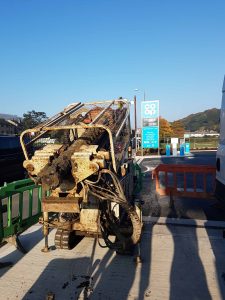
The site investigation industry has, traditionally, relied on light cable percussion (generally known as shell and auger) drilling. This is slow, messy and crude providing low quality geotechnical and environmental samples at best. Thankfully, these days it isn’t the only option available to you.
The majority of our general site investigation drilling is done using hollow stem rotary methods. These provide signficantly better quality data with minimal sample disturbance, even in the toughest of conditions. This week we were working at a site underlain by glacial and millstone grit cobbles, sand and terrace gravels in a sandy clay matrix. We drilled five boreholes to their target depth on 8m in one working day – something that might have taken a shell and auger crew a week – minimising the disruption to our client’s business which was able to remain open throughout.
Why Coring Isn’t Boring
It probably comes as no surprise that it takes a very different skillset and completely different equipment to core through rock as opposed to boring through the sand and clay soils that are more commen near the ground surface.
The correct core bit (i.e. the part of the drill string which cuts the rock) selection is the key to obtaining high quality quality core samples. Each rock type requires a specific core bit to cut it cleanly and efficiently. So, to achieve the best results, we carry a range of different core bits with us at all times. Our drilling crew recently used our T6 coring barrel to core to depths of 25m in a range of geology from conglomerates to slate and everything in between.
So, you might say that coring is not boring. Fact!
Where There’s Muck There’s Brass
 Last week we undertook window sampling and installed monitoring wells at one of the largest recycling processing depots in the UK. Have you ever wondered what happens to your recycling after it gets taken away? Well it will likely end up at a processing centre similar to this one, where the waste is separated, segregated and prepared for recycling.
Last week we undertook window sampling and installed monitoring wells at one of the largest recycling processing depots in the UK. Have you ever wondered what happens to your recycling after it gets taken away? Well it will likely end up at a processing centre similar to this one, where the waste is separated, segregated and prepared for recycling.
It was eye opening to see the scale of the operation. Usually when we drill, our rig is one of the bigger vehicles on site, but this time our van mounted Geoprobe was dwarfed by some of the other machines on site.
Heathrow Third Runway
OK so we can’t say whether this will (or should) get the final go ahead from government. But what we can say with absolute confidence is that we have more experience of working airside at Heathrow than any other geo-environmental consultant.
We are the only consultant with permanent airside passes, both for our staff and our vehicles. We are also well versed in navigating our way through the airport’s complicated permiting system.
Just last week one of our investigation teams worked through the night to install several deep monitoring wells adjacent to one of the existing runways. The third runway will need thousands of similar geotechnical borehole drilling in the next few years. We believe that having an airside presence and an in depth knowledge of the geology gives us a head start when it comes to providing this service.
For more information please contact James Skinner – 01296 739411
Cathodic Protection
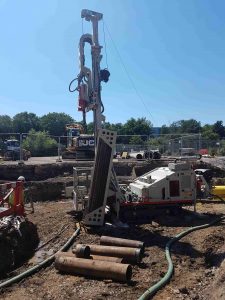
Drilling large diameter boreholes at a brownfield site to install anodes for a cathodic protection system requires a rather eclectic combination of skills.
Working in a tight space, to a detailed specification, we achieved an anode installation through a complex sequence of geological strata. Clean drilling techniques required us to install an environmental seal through surficial gravels and 30m into underlying clay. We then extended the boreholes through 20m of Thanet sands and 10m of flinty chalk. To complete the anode installation we then tremmied sacrificial coke contact media into the borehole’s response zone with the remainder of the boreholes being grouted back to the surface with bentonite.
Our team consisted of drillers, environmental engineers, mud technicians and cathodic protection engineers, all working together on a busy site to ensure the client got the installation required whilst working within the Environment Agency guidelines. The anodes will now ensure the pipelines are protected for the next 100 years.
If you’d like to know more or if you have an installation requiring cathodic protection be installed then please contact Angus Gale – 01296739433
What TLC Can Achieve
Our Terrier drill rig, Tinky, recently celebrated its sixteenth birthday. In that time it has had 2 new head gaskets, 15 calibrations, 22 oil changes and services, 2 new tyres, 2 new tracks, 1 rebuilt mast frame, 1 new radiator , 1 new weight guard and a new fan. We know that good maintenance is the key to keeping any machine working and we like to think we’ve done our Terrier proud. It has certainly paid us back.
It may be sixteen years old but last week it still managed to dynamically sample 25m of weathered sandstone to 5m depth with SPT tests every metre plus completing an additional four dynamic probes to competent bedrock at 9.5m and installing four gas monitoring wells to 1.5m. All this in two days including a round trip mobilidsation of over 300 miles. Hats off to Tinky.
We are looking for dynamic sampling operatives. If you think you fit the bill then give Angus Gale a call on 01296 739400 or email your CV to Angus Gale.
Rapid ‘CBR’ Testing
Let’s face it, sometimes you just need CBR results fast. Really fast. Maybe you need to identify any soft spots in a piling mat or in a road sub-base before the compaction plant leaves site. Or – be honest – maybe you just forgot to get the required testing done in time. Either way, we have a solution for you. We can test your sub-base using our Clegg Impact Hammer, typically completing 80+ tests in a day with results available immediately. Although the CBR value measurements aren’t as accurate as those obtained from a conventional test, we reckon they are acceptable for about 90% of the enquiries we receive.
For further information please contact Steven Partridge – 01296 739413
Airplanes Stopped Play
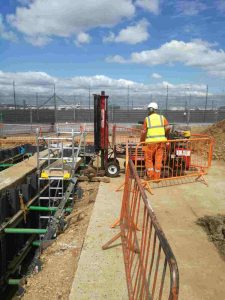 Another post discussing the joys of working at a busy airport. This time we were asked to advise on the allowable bearing capacity for a foundation to be installed at 2m depth, without either excavating a trial pit of drilling a borehole.
Another post discussing the joys of working at a busy airport. This time we were asked to advise on the allowable bearing capacity for a foundation to be installed at 2m depth, without either excavating a trial pit of drilling a borehole.
We opted to carry out a series of dynamic probes, using our lightweight terrier drill rig, along the line of excavation, using the data to calculate an equivalent SPT ‘N’value and thence an allowable bearing capacity. We were able to provide our client with results in real time, ensuuring there were no delays to the construction programme.


